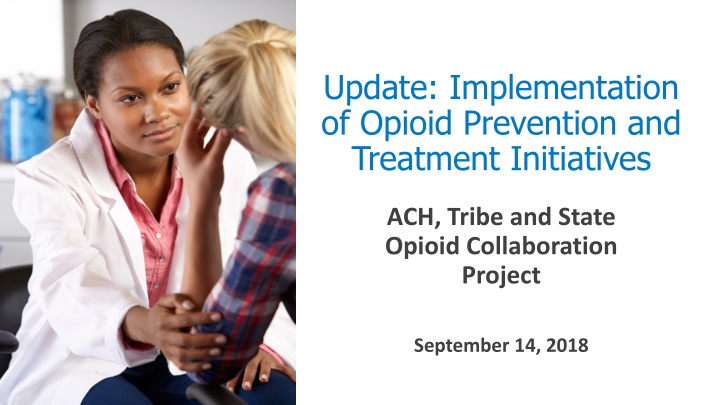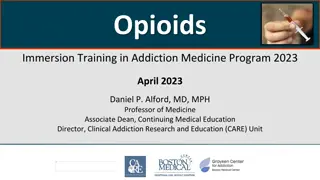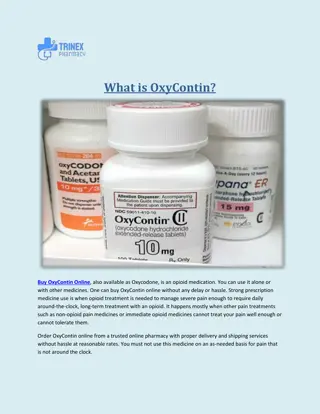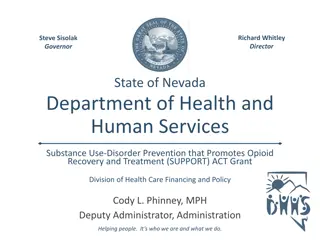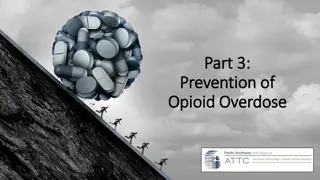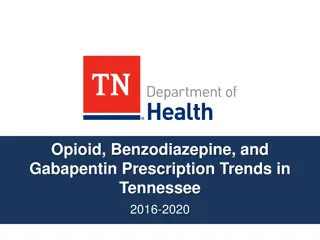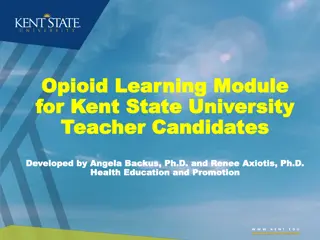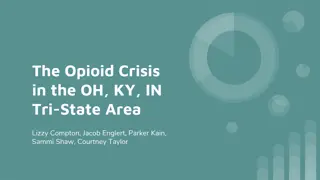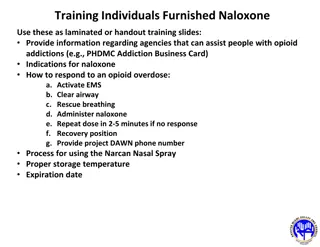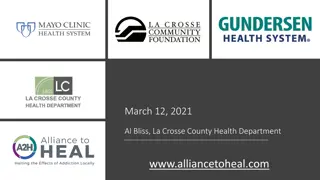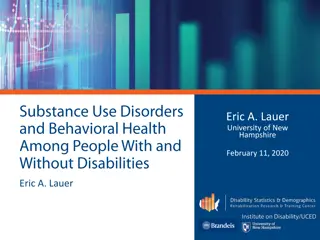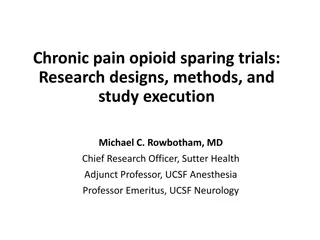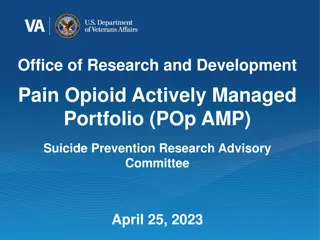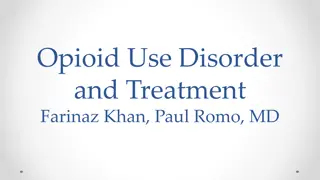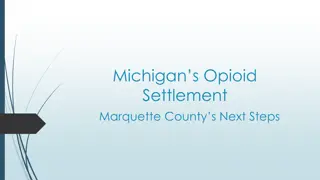Washington State's Opioid Prevention and Treatment Initiatives Update
Washington State is actively implementing opioid prevention and treatment initiatives to address the rising opioid-related overdose deaths and disparities. The state's response plan includes tackling gaps in prevention, treatment, and recovery support to reduce the opioid disease burden. Key data highlights the impact of opioids in Washington, emphasizing the need for comprehensive strategies to combat the crisis.
Download Presentation

Please find below an Image/Link to download the presentation.
The content on the website is provided AS IS for your information and personal use only. It may not be sold, licensed, or shared on other websites without obtaining consent from the author.If you encounter any issues during the download, it is possible that the publisher has removed the file from their server.
You are allowed to download the files provided on this website for personal or commercial use, subject to the condition that they are used lawfully. All files are the property of their respective owners.
The content on the website is provided AS IS for your information and personal use only. It may not be sold, licensed, or shared on other websites without obtaining consent from the author.
E N D
Presentation Transcript
Update: Implementation of Opioid Prevention and Treatment Initiatives ACH, Tribe and State Opioid Collaboration Project September 14, 2018
Presenters Caleb Banta-Green, PhD MPH MSW Jason McGill, JD Charissa Fotinos, MD, MSc Kathy Lofy, MD ______ Senior Policy Advisor ______ Deputy Chief Medical Officer, Clinical Quality and Care Transformation _____ State Health Officer _____ Interim Director & Principal Research Scientist
Overview Jason McGill Senior Policy Advisor Governor s Office Caleb Banta-Green Interim Director and Principal Research Scientist UW ADAI
Overview: Our State Opioid Prevention and Treatment Initiatives Overview Dr. Kathy Lofy, Chief State Health Officer, Dept. of Health Dr. Charissa Fotinos, Deputy Chief Medical Director, Health Care Authority Dr. Caleb Banta-Green, Interim Director & Principal Research Scientist, UW ADAI
Opioid-Related Overdose Deaths 20002017* Earlier this year we saw an overall decline but now we are experiencing an increase driven by synthetic opioids/ Fentanyl much of it is probably illicit/ counterfeit. Good news: We are experiencing a nearly 50%, now sustained, decline in Rx use. Source: DOH Death Certificates (Note: prescription opioid overdoses exclude synthetic opioid overdoses) *Data for 2017 are preliminary as of 8/23/2018.
Opioid-Related Disease Burden in Washington Deaths 740 Opioid Overdose Hospitalizations 1,615 Opioid Substance Abuse Treatment Admissions 14,389 Persons 12+ years who misused pain-relievers in the past year 324,000 1. Opioids involved in an overdose death listed as underlying cause of death. Washington preliminary death certificate data, 2017. 2. Washington Hospital Discharge Data, Comprehensive Hospitalization Abstract Reporting System (CHARS), 2017. 3. Treatment and Assessment Report Generation Tool, 2015. 4. National Survey on Drug Use and Health, 2015-2016.
Strong State Opioid Response Plan/Executive Order Plan Just Updated We still have gaps: 1. Prevention Schools Public Health 2. Treatment Pregnant and parenting women People who are justice involved Community behavioral health system 3. Recovery supports Priority Goals Goal 3: Reduce morbidity & mortality Goal 4: Use data to monitor & evaluate Goal 1: Goal 2: Treat opioid use disorder Prevent opioid misuse & abuse Prevent misuse in youth & improve prescribing practices Expand access to treatment Distribute naloxone to heroin users Optimize and expand data sources Priority Actions Source: https://www.doh.wa.gov/YouandYourFamily/PoisoningandDrugOverdose/OpioidMisuseandOverdosePrevention
Key Action Items Stemming from State Plan Partners Task Lead Expected Outcome Status Due Date DOH / B&Cs Agency Medical Directors Groups New pain rules, Prescribing reports In Progress This Fall Implement HB 1427 Develop prescribing rules Use PMP data to improve prescribing DSHS HCA Improved access to treatment and decrease overdose deaths In Progress; Hub and spokes statewide; public campaign begun In Progress STR grant ends April 2019; SOR grants begins soon Grant ends Sept 2021 Implement State Targeted Response grant (18 projects); new State Opioid Response grant & State funding Expand Hub & Spoke Implement public education campaign Implement Prescription Drug Overdose grant Provide overdose education Purchase/distribute naloxone UW ADAI DOC DOH DSHS UW ADAI DOH Increased use of naloxone use by first responders and the public DSHS CJ, DOC, AG, Jails, HIDTA, ADAI, Juvenile Justice HCA DSHS DOH Increased use of evidence- based treatment Plan completed; working on leg. & DP Potential policy & 2019-21 Budget Criminal Justice Work Group and develop work plan Increase MAT and decrease overdose deaths In Progress Plans due Nov 2017 Support Accountable Communities of Health with opioid-related transformation projects Non-pharmacological treatment for pain (collaborative care; CBT/PT OT; chiropractic; acupuncture; massage etc.) HCA Professions, LNI Literature review and assessment of evidence for recommendation for new services in Medicaid Review finished; decision package 2019-21 Budget
Years of Good Work in Our State re: Safe Opioid Prescribing and Reducing the Supply Opioid prescribing rules ER for emergencies initiative Dental prescribing guidelines Prescribing metrics Provider feedback reports Prescribing limits for Medicaid clients and for public employees Raising awareness about non-opioid alternatives Offering tele-pain consulting to providers Launching youth prevention programs Opioid criminal justice and drug/gang task forces Legal action against opioid prescription manufacturer Eliminating pill mills through regulation and enforcement
CDC Opioid Guidelines-March 2016 Determining When to Initiate or Continue Opioids for Chronic Pain 1. Nonpharmacologic therapy and nonopioid pharmacologic therapy are preferred for chronic pain. Clinicians should consider opioid therapy only if expected benefits for both pain and function are anticipated to outweigh risks to the patient. If opioids are used, they should be combined with nonpharmacologic therapy and nonopioid pharmacologic therapy, as appropriate. 2. Before starting opioid therapy for chronic pain, clinicians should establish treatment goals with all patients, including realistic goals for pain and function, and should consider how therapy will be discontinued if benefits do not outweigh risks. Clinicians should continue opioid therapy only if there is clinically meaningful improvement in pain and function that outweighs risks to patient safety. 3. Before starting and periodically during opioid therapy, clinicians should discuss with patients known risks and realistic benefits of opioid therapy and patient and clinician responsibilities for managing therapy.
CDC Opioid Guidelines-March 2016 Opioid Selection, Dosage, Duration, Follow-Up, and Discontinuation 4.When starting opioid therapy for chronic pain, clinicians should prescribe immediate-release opioids instead of extended-release/long-acting (ER/LA) opioids. 5.When opioids are started, clinicians should prescribe the lowest effective dosage. Clinicians should use caution when prescribing opioids at any dosage, should carefully reassess evidence of individual benefits and risks when increasing dosage to 50 morphine milligram equivalents (MME)/day, and should avoid increasing dosage to 90 MME/day or carefully justify a decision to titrate dosage to 90 MME/day. 6.Long-term opioid use often begins with treatment of acute pain. When opioids are used for acute pain, clinicians should prescribe the lowest effective dose of immediate-release opioids and should prescribe no greater quantity than needed for the expected duration of pain severe enough to require opioids. Three days or less will often be sufficient; more than seven days will rarely be needed. 7.Clinicians should evaluate benefits and harms with patients within 1 to 4 weeks of starting opioid therapy for chronic pain or of dose escalation. Clinicians should evaluate benefits and harms of continued therapy with patients every 3 months or more frequently. If benefits do not outweigh harms of continued opioid therapy, clinicians should optimize other therapies and work with patients to taper opioids to lower dosages or to taper and discontinue opioids.
Why Consider Post-op Pill/Duration Recs? The vast majority of pills prescribed post-op are left over and may be used for subsequent misuse or diversion Voepel-Lewis et al, JAMA Pediatrics 2015; 169: 497-8-leftover pills in kids via parent diaries T&A 52 pills dispensed 44 pills left (day 4) MSK 34 pills dispensed 30 pills left Minor abd, 31 pills dispensed 28 pills left GU,periph proc 1 million opioid na ve patients undergoing surgery Composite outcome dependence, abuse or overdose Total duration of opioid use was the strongest predictor of misuse, with each refill and additional week of opioid use associated with an adjusted increase in the rate of misuse of 44.0% Highest risk in 15-24 yr age group Brat et al, BMJ 2018;360:j5790 http://dx.doi.org/10.1136/bmj.j5790
Continued Use by Initial Days of Therapy MMWR March 17, 2017 40 35 Probability of continuing use in % 30 25 20 15 10 5 0 0 5 10 Number of days of first episode of opioid use 15 20 25 30 35 40 45 One year probability Three year probability Source: Shah et al. MMWR 2017 Mar 17;66(10):265-9 16
Acute Opioid Prescribing by Specialty Source: DOH Prescription Monitoring Program Data 17
Bree/AMDG Dental Guideline Recommendations Conduct a thorough history including dental and medical Prescribe non-opioid analgesics as first line Consider pre-surgical or pre-emptive medication If an opioid is warranted, follow the CDC guideline (lowest effective dose of immediate-release opioids; 3 days will be sufficient) Limit to 8-12 tablets for adolescents and young adults through 24 years old Avoid opioids when patient/parent requests no opioid prescription or patient is in recovery and at high risk of relapse for SUD Educate on appropriate use, duration and adverse effects of opioids and share information on disposal of leftover opioids Support patients with SUD who are undergoing dental procedure Gary M. Franklin, MD, MPH, FAAN 19
Washington Bree Opioid Metrics General prescribing Prevalence of opioid use % with 1 opioid Rx of all enrollees, by age Long-term prescribing Chronic opioid use % with 60 days supply of opioids in the quarter High dose use % with doses 50 and 90 mg/day MED in chronic opioid users Concurrent use % with 60 days supply of sedatives among chronic opioid users Short-term prescribing Days supply of first Rx % with 3, 4-7, 8-13, and 14 supply among new opioid patients Transition of chronic use % new opioid patients transitioning to chronic use the next quarter Morbidity and Mortality Opioid overdose deaths Rate of overdose deaths involving opioids Non-fatal overdoses Rate of non-fatal overdoses Opioid use disorder Rate of opioid use disorder among patients with 3 quarters of use
WA Bree Opioid Use Disorder Treatment Recommendations
A Note about Prescribing Opioids in Older Adults Goal Reduce risk of falls Follow same best practices for prescribing opioids (AMDG) Prescribe immediate-release opioids at the lowest effective dose (AMDG) o Initiate opioid therapy at a 25% to 50% lower dose than that recommended for younger adults. Source: AHRC 22
1.2.A.i: Decrease the rate of Opioid overdose deaths from 9.8 per 100,000 in 2015 to 9.0 in 2020 Efforts Working to Reduce Rx: Painkiller Use Down by 8th, 10th, 12th Graders Q.Use a painkiller to get high, like Vicodin, OxyContin or Percocet, in last 30 days? 20% 8th Grade 10th Grade 12th Grade 15% 10% 5% 0% 2006 2008 2010 2012 2014 2016 Source: WA State Healthy Youth Survey provided by BHA-DSE
Our Focus Now Is Treatment & Recovery Data shows more treatment is needed What is effective opioid treatment? How are we addressing access to treatment?
1.2.A.i: Decrease the rate of Opioid overdose deaths from 9.8 per 100,000 in 2015 to 9.0 in 2020 Treatment Coverage for Medicaid Clients With Opioid Use Disorder by Accountable Communities of Health, 2016, Shows Significant Gap Receiving methadone or buprenorphine SW Washington Not receiving methadone or buprenorphine Pierce Olympic North Sound North Central King Greater Columbia Cascade Pacific Better Health 0 2000 4000 6000 8000 10000 12000 14000 16000 18000 Number of patients with OUD SOURCE: Health Care Authority Provider One
1.2.A.i: Decrease the rate of Opioid overdose deaths from 9.8 per 100,000 in 2015 to 9.0 in 2020 Many People in Washington Are Not Getting Treatment What types of help would you want if they were easy to get? How interested are you in reducing or stopping your opioid use? 56% medication treatment Not interested 20% 39% detox Not sure 34% individual counseling for addiction Very 51% 8% Somewhat 21% Source: UW Alcohol and Drug Abuse Institute, WA State Drug Injector Health Survey, 2017
1.2.A.i: Decrease the rate of Opioid overdose deaths from 9.8 per 100,000 in 2015 to 9.0 in 2020 What Is Medication for Opioid Use Disorders? Methadone Delivered by Opioid Treatment Providers (OTPs) Buprenorphine Delivered by providers in office-based practice & OTPs Naltrexone Delivered by providers in office-based practice 27
How Are We Addressing Access to Treatment? Answer: WA State Hub and Spoke Opioid Treatment Network Nurse care manager helps patients and providers coordinate care, reduce barriers and, improve overall health Spokes - Clinic Treatment Med. Maintenance REFERRALS FROM Community outreach staff Priority populations: Pregnant and parenting women & justice involved Spokes - SES Treatment Med. Maintenance Hubs Treatment Med. Induction & Stabilization REFERRALS FROM Recovery Helpline Spokes Mobile unit Treatment Med. Maintenance Treatment decision making- ongoing Care navigation- ongoing Caleb Banta-Green calebbg@uw.edu 09/12/17, adapted
Federal required metrics show that our Hub and Spoke Opioid Treatment Networks are outperforming goals. Over 3,221 people in treatment Proof of concept proven we must expand statewide Full report available
Current Future expansion Legislature expanded Hub and Spoke Opioid Treatment Networks to Cover Entire State Contracts are near final for 5 new Hubs, each with a minimum of 5 spokes New Hubs include: Comprehensive Healthcare Yakima Ideal Option Everett MultiCare Health System Spokane Olympic Peninsula Health Services Port Hadlock Providence NE Washington Medical Group Colville
Other Notable Work Legislature funded recovery helpline improvements to track MAT provider capacity ~Real time with 2-1-1 system (operational ~December 2018) FYI: For help with addiction, contact the Washington Recovery Helpline at 1 866 789 1511 or visit https://www.warecoveryhelpline.org/ Statewide multi-media campaign to promote the helpline (January 2019) Grant program for Tribal-specific strategies to treatment and prevention Drug take-back program public messaging and supports Youth drug prevention funding in schools/high need areas Substance use disorder peer support counseling and recovery services Statewide electronic emergency (EMS) data system to report overdoses and near overdoses, and to connect with peer recovery Prescription Monitoring Program improvements to integrate with electronic health systems and provider feedback reports County pilot program for substance use disorder diversion from the criminal justice system
Purdue and other actions underway State Manufacturer defendants Distributor defendants OKL June 2017 NH Aug 2017 NJ Oct 2017 NM Sept 2017/Dec 2017 Purdue, Teva, Janssen, Allergan Purdue WA Sept 2017 AL Feb 2018 AK Oct 2017 AR Apr 2018 Cherokee April 2017 Purdue Purdue Purdue Purdue, Teva, Janssen, Endo, Allergan Cardinal, McKesson, Amerisource Bergen Purdue Purdue, Janssen, Endo NV May 2018 NC May 2018 ND May 2018 Puerto Rico Mar 2018 Purdue Cardinal, McKesson, Amerisource Bergen, Purdue Purdue DE Jan 2018 KY Nov 2017 Purdue, Endo Cardinal, McKesson, Purdue Endo Cardinal, McKesson, Amerisource Bergen OH June 2017/ Feb 2018 (dist) Purdue, Teva, Janssen, Allergan, Endo Cardinal, McKesson, Amerisource Bergen, Miami-Luken FL May 2018 Purdue, Teva, Janssen, Endo, Allergan, Mallinckrodt Cardinal, McKesson, Amerisource Bergen SC Aug 2017 SD Mar 2018 TN May 2018 TX May 2018 WV Purdue LA Sept 2017 MS Dec 2015 MO June 2017 MT Nov 2017 Purdue, Teva, Janssen, Endo, Allergan Purdue, Teva, Janssen, Endo, Allergan Purdue, Endo, Janssen Purdue, Janssen, Endo Purdue Purdue McKesson Purdue 35
Note on Congressional Legislation Efforts to reduce illicit Fentanyl from entering the country by closing US Postal Service loopholes, requiring foreign packages to reveal contents Support for people in treatment and recovery Reauthorizes CURES act SAMHSA grant program for community opioid recovery centers (ECHO model) HHS to determine best practices and then implements e.g. use of recovery coaches HHS to create plan of safe care for babies born dependent to opioid drugs HHS grants to support people in recovery with employment and housing Lifts MAT cap from 100 to 275 and establishes grant program to help providers Expands grant program for first responders Research for non-opioid treatment for chronic pain Budget is NOT allocated, some estimate it might be ~$8B It does NOT change IMD exclusion or behavioral health info sharing (42 CFR 2 but it does direct HHS to study it)
Reconsider 2018 Legislation (HB 2489/SB 6150) (Passed House unanimously but ran out of time in Senate) Takes next steps for prevention and recovery Concentrates youth prevention in high-needs areas Improves Prescription Monitoring Program integration with EHR Requires patient notification of opioid prescriptions (now in new proposed rules) Uses EMS near-overdose response; connects with peer supports Ensures more access to Naloxone with statewide standing order Provides for rapid-response team for areas experiencing overdoses Requires drug and gang task force coordination Funds diversion programs and tribal-specific strategies Plans for better use of non-pharmacological treatment for pain Consider budget investments for serious gaps treatment for: (1) Pregnant and parenting women & (2) Justice-involved Other items include Non-pharm services in Medicaid; PMP integration; & Connections with community behavioral health system, generally Focuses on treatment for people with opioid use disorder Sets up statewide community hub & spoke opioid treatment networks Increases Medicaid rate (to Medicare level) paid to providers to treat people Updates clinical terminology in statute, removes stigma Requires state Medicaid waiver for treatment while people are incarcerated Funds services for people while incarcerated to reduce recidivism Requires metrics, reporting
Department of Health Updates Kathy Lofy, MD State Health Officer Department of Health
Engrossed Substitute House Bill 1427 (2017) Opioid prescribing rules Cover prescription limits for acute pain, PMP checks, and threshold for consultation Medical Commission rules will be effective January 1, 2019 Rules from other four Boards/Commissions anticipated to be effective November 1, 2018 Prescribing feedback reports determined metrics, obtained providers specialty data, calculated metrics Washington State Hospital Association Coordinated Quality Improvement Program shared PMP data Prescriber overdose notifications using Emergency Department Information Exchange and PMP data will pilot this month WA State DOH | 39
Fewer People are Receiving Opioid Prescriptions 180 Patients with an Opioid Prescription 160 140 per 1000 population 124 120 100 80 75 60 41 40 20 17 0 2012Q1 2013Q1 2014Q1 2015Q1 2016Q1 2017Q1 2018Q1 10 17 years 18 24 years 25 44 years 45 64 years Source: Prescription Monitoring Program (https://www.doh.wa.gov/DataandStatisticalReports/HealthDataVisualization) Note: Tramadol became a controlled substance in August 2014. WA State DOH | 40
Days Supply of New Opioid Prescriptions 60 50 50 Percent of Patients 40 34 30 20 10 6 10 0 2012q1 2013q1 2014q1 2015q1 2016q1 2017q1 2018q1 0 3 days 4 7 days 8 13 days 14 59 days Source: Prescription Monitoring Program (https://www.doh.wa.gov/DataandStatisticalReports/HealthDataVisualization Note: A patient with a new opioid prescription is a person who filled an opioid prescription in the current quarter but not in the previous quarter. Days supply refers to the estimated number of days the prescription will last. All authorized refills are included in the days supply, even if they were not filled because they reflect the prescriber s prescribing. Opioid prescriptions prescribed for more than 59 days supply are excluded. WA State DOH | 41
Other substances on rise too 2000 2017* Any drug Rx (non-fentanyl) Any opioid Psycho-stimulant Heroin Synthetic 18 Age-adjusted rate per 100,000 16 1167 14 12 10 740 # of deaths 8 6 392 342 306 Psycho-stimulant 4 2 142 0 Source: DOH Death Certificates (Note: prescription opioid overdoses exclude synthetic opioid overdoses) *Data for 2017 are preliminary as of 8/23/2018. WA State DOH | 42
Washington Opioid Overdose Deaths, 2017* Of these 277 deaths 77 (28%) involved a sedative 33 (12%) involved alcohol 102 (37%) involved either a sedative or alcohol Both illicit & prescription opioid, n=65 Prescription opioid only, n=277 Illicit opioid only, n=373 *Source: DOH Death Certificates (Data for 2017 are preliminary as of 8/23/2018) Note: 25 opioid overdose deaths were not able to be classified WA State DOH | 43
Prescription Monitoring Program Queries Are Increasing 16,000,000 14,000,000 12,000,000 10,000,000 8,000,000 6,000,000 4,000,000 2,000,000 0 2012 2013 2014 2015 2016 2017 2018 2012 2013 2014 2015 2016 2017 2018 (estimated) Controlled Substances Dispensed Prescriber Query Pharmacist Query HIE Query Source: Department of Health Prescription Monitoring Program WA State DOH | 44
Treatment Charissa Fotinos, MD, MSc Deputy Chief Medical Director Health Care Authority
Background Braided funding and cross-agency, multisector work has resulted in a four-fold increase in the number of persons accessing medication for opioid use disorder Through this work, treatment gaps have been particularly noticeable in two populations: Pregnant or parenting persons Criminal justice system-involved persons
Growth in Medication Prescribing for Opioid Use Disorder Among Medicaid Clients 21,558 15,259 13,056 12,129 9,839 9,429 8,297 8,257 7,300 6,916 5,021 4,947 4,017 3,080 984 2013 2014 2015 2016 2017 Any MAT Methadone MAT Buperenorphine MAT SOURCE: Provider One client Eligibility tables (HCA) & Client Outcomes Database (DSHS RDA). Note: Excludes dual eligibles and persons with third-party liability; includes all Medicaid eligibles in the year with Medication assisted treatment (MAT)
Successful Initiation of Medication With State Targeted Response Funds STR targets for medication treatment have been greatly exceeded How can we sustain these gains as funding sources change? 48
Pregnant and Parenting Persons Dramatic increase in U.S. rate of opioid use disorder identified at labor and delivery Washington State rates of neonatal abstinence syndrome also rising https://www.cdc.gov/mmwr/volumes/67/wr/mm67 31a1.htm?s_cid=mm6731a1_w 49
Current Programs for Pregnant and Parenting Persons Parent-Child Assistance Program (PCAP) 3 year home visitation model Care managers provide linkage, support, transportation, and referral to treatment Increased support from Legislature with 2018 budget Pregnant Parenting Women (PPW) Residential substance use disorder treatment services Housing support services Therapeutic intervention for children 50
